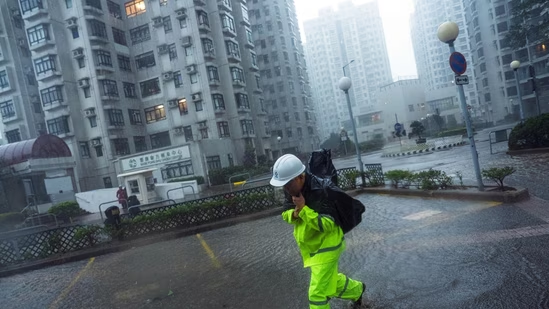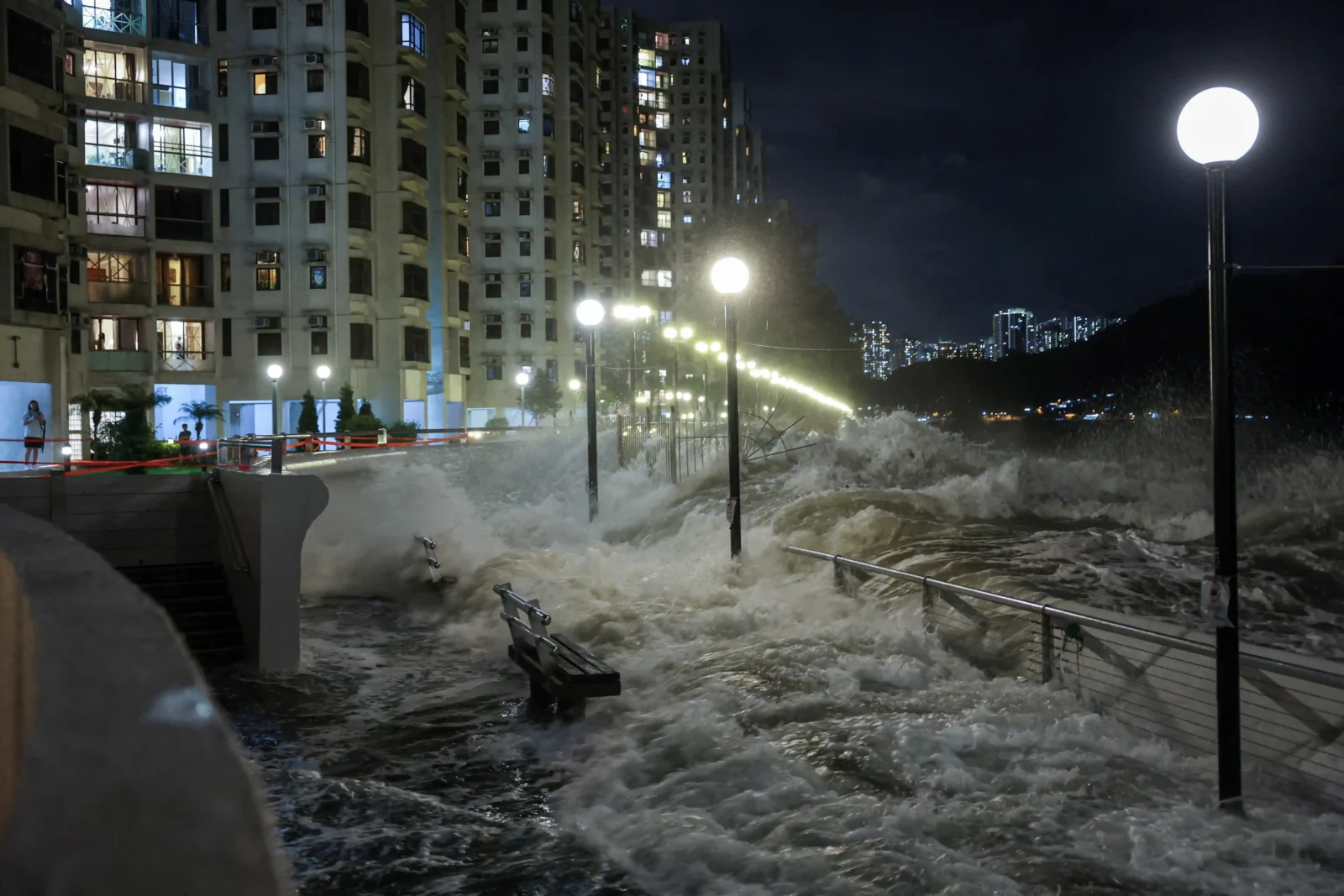The fury of Super Typhoon Ragasa bore down across East Asia, overwhelming communities from Taiwan’s east coast to Hong Kong’s skyscrapers and the densely populated bays of southern China. Its unique scale—winds topping 165 miles per hour, a radius of over 320 kilometers—turned landscapes, roads, and river towns into scenes of devastation. Ragasa’s story is not just one of meteorological force, but of human resilience, rescue, and the harsh lessons of climate risk.
Taiwan: When Water Becomes a Wall
The barrier lake disaster
On Tuesday, Hualien County in eastern Taiwan faced what locals called a “tsunami”—not from the sea, but from a barrier lake that had formed after landslides triggered by days of rain. When the makeshift dam burst, a wall of muddy water tore through Guangfu township, sweeping away a major bridge, homes, vehicles, and forcing people to higher floors or roofs to escape.
- Fatalities: At least 14 confirmed dead; more than 124 missing after water swept entire neighborhoods.
- Rescue efforts: Evacuation of nearly 8,000 people; ongoing search for stranded and missing residents. Footage shows roads erased and cars in living rooms.
- Infrastructure loss: Bridge collapse, electric outages, impassable roads. Entire villages like Dama reported hundreds still stranded, their supplies cut off.
The storm’s impact left local chiefs and fire officials scrambling to reach survivors, with chaos at shelters and supply bottlenecks.
The flood’s human toll
Among the missing were families, children, and rescue teams. Social media lit up with scenes of flooded towns, while rescuers described racing against further landslides and rising water. Relatives waited in evacuation centers, hoping for news as rescuers worked night and day amid collapsed bridges and blocked roads.
Hong Kong: Glass, Concrete—and Floods
Off-the-charts wind and water
Hong Kong braced for Ragasa by canceling hundreds of flights, shuttering schools, businesses, and even Disneyland. Most of the city’s 7.5 million residents watched in awe (and fear) as hurricane-force winds toppled trees, shattered glass, and whipped up storm surges over three meters high.
- Stranded travelers: Hong Kong International Airport canceled over 600 flights; shops and eateries stayed open for days to shelter thousands stuck by the storm’s shutdowns.
- Hotel flooding: One viral video captured powerful waves smashing through a hotel’s glass doors—flooding the lobby, sweeping furniture, and forcing staff to rescue guests.
- Infrastructure and street chaos: Promenades were submerged, playgrounds destroyed, and public transport stopped. Trees crashed through streets, glass railings and building exteriors were shredded.
The science behind the peril
Local authorities compared Ragasa’s force to previous super typhoons Mangkhut (2018) and Hato (2017), which together injured hundreds and caused billions of dollars in damage. This time, the city’s observatory warned more severe surges and wind dangers—and researchers flagged an uptick in typhoon intensity due to climate change.
Philippines: Already Flooded, Hit Again
Northern Philippines, still recovering from earlier storms, braced for days of rain, landslides, and new flash floods as Ragasa made landfall with maximum intensity.
- Casualties: At least four deaths confirmed; evacuations in rural villages.
- Evacuation: Thousands moved to shelters; transport and classes canceled for safety.
- Flooded provinces: Remote islands and upland areas saw rivers burst, roads erased, and emergency responders stretched thin.
South China: Mass Movement and Precaution
Ragasa’s advance brought widespread closures, suspended rail travel, and millions of residents into shelters. In Guangdong, authorities ordered schools, businesses, and public offices to close; up to 400,000 planned evacuations in Shenzhen alone.
Shelter and rescue mobilization
Local governments ran around-the-clock rescue operations, moving food, beds, and medical care into temporary shelters for over 760 residents at last count—numbers rising as the storm tracked westward.
- Transport halt: Train stations across Guangdong deserted; entire lines suspended to minimize risk.
- Coastal defences: Boats grounded, glass railings smashed, and power cut to flood-prone districts (notably in Macau and Yangjiang).
- Dramatic visuals: Giant shelf clouds rolling over Lamma Island, Hong Kong—caught on camera, crystallizing how the storm’s “atmospheric engine” dwarfed city skylines.
Scary Visuals: Witness to Destruction

Shelf cloud over Hong Kong
Spectacular footage showed a giant, rolling cloud canopy sweeping over Hong Kong’s Lamma Island, creating an ominous curtain across the sky—visual shorthand for Ragasa’s monstrous power.
Waters entering hotels, streets, and homes
Multiple videos chronicled floodwaters bursting into buildings, sweeping men and furniture from lobbies, inundating restaurants and cycling paths, and submerging cars, playgrounds, and entire riverside districts.
Bridges ripped apart
Ragasa’s winds and debris tore roof panels off bridges, toppled hundreds of trees, and sent boats onto shore, breaking glass railings along coastal walkways. The bridge collapse in Taiwan, uniquely filmed in real time, became the emblem of the storm’s destructive force.
Towns transformed
Wide-angle shots from Taiwan and southern China showed “raging rivers” taking over townships, mud and debris blocking roads, and families seeking refuge far from ground level. Rescuers began searching house-to-house, guided by drone footage and calls from the stranded.
The Challenge of Recovery
- Power and water outages: Rebuilding infrastructure, from bridges and roads to water systems and electricity, began immediately—sometimes amid ongoing rain and landslides.
- Medical and evacuation needs: Hospitals received dozens of injured from flooding, debris, and accidents. Supply lines struggled against blocked highways and torn transmissions.
- Communication problems: With bridges destroyed and rivers running high, local cell service and rescue coordination faced repeated outages, making search-and-rescue slow and risky.
Climate and Preparedness: Hard Lessons
UN scientists warn that warming seas sharpen the power of typhoons, with wind speeds and rainfall climbing year-on-year—even as the frequency of storms may drop over time. Experts say governments must strengthen infrastructure, expand shelters, and develop earlier warning networks:
- Stricter zoning: No new construction in flood-risk zones.
- Flood defence: Levees, barriers, and raised roads for high-risk towns.
- Emergency operations: Community-trained volunteers, drones, and food kits ready before the next storm.
Community and Survival: The Human Story
Ragasa is more than meteorology—it’s families escaping roof-high waters, rescue teams plucking people from second stories, and shelters improvising for hundreds overnight. The scale of loss—homes, roads, loved ones—reminds us that resilience is collective, and rebuilding is as much about community as concrete.
Conclusion
Super Typhoon Ragasa set new marks for wind, rain, and destruction across East Asia. In Taiwan, Hong Kong, the Philippines, and southern China, its legacy is visible in collapsed bridges, flooded homes, and the sudden reshaping of entire landscapes—and even more, in the stories of those who survived, helped, and mourned. As the region rebuilds, Ragasa stands as both a warning and a challenge: climate resilience is urgent, and preparedness must keep pace with a world of rising storms.
References / Sources
- Times of India – Super Typhoon Ragasa: Storm wrecks havoc in Taiwan, Hong-Kong, Philippines, South China: https://timesofindia.indiatimes.com/world/china/super-typhoon-ragasa-storm-wrecks-havoc-in-taiwan-hong-kong-philippines-south-china-scary-visuals-emerge/articleshow/124082251.cms
- BBC News – Super Typhoon Ragasa: China evacuates nearly two million: https://www.bbc.com/news/live/c0m44dlndnrt
- Reuters – Super Typhoon Ragasa soaks Hong Kong, death toll rises: https://www.reuters.com/business/environment/super-typhoon-lashes-hong-kong-with-hurricane-force-winds-heavy-rain-2025-09-23/
- CNN – Deadly Typhoon Ragasa slams into Hong Kong, other cities in China: https://www.cnn.com/2025/09/23/asia/typhoon-ragasa-hong-kong-southern-china-impact-intl-hnk
- India Today – Super Typhoon Ragasa lashes eastern Taiwan, 14 killed, 124 missing: https://www.indiatoday.in/world/story/14-dead-124-missing-after-super-typhoon-ragasa-lashes-eastern-taiwan-2792360-2025-09-24
- BBC News – Typhoon bursts Taiwan lake as strongest storm barrels through Asia: https://www.bbc.com/news/articles/c3rvjj7dp7ro
- Economic Times – Super Typhoon Ragasa wreaks havoc in Hong Kong, death toll rises in Taiwan: https://economictimes.com/news/international/hong-kong/super-typhoon-ragasa-taiwan-lake-burst-hong-kong-flooding-hualien-county/articleshow/124083481.cms
- DD News – Super Typhoon Ragasa soaks Hong Kong, death toll rises in Taiwan: https://ddnews.gov.in/en/super-typhoon-ragasa-soaks-hong-kong-death-toll-rises-in-taiwan/
- CNN – Bridge Collapses as Typhoon Ragasa Floods Taiwan: https://www.youtube.com/watch?v=IzM7N7DjSF8
- BBC News – Flood destroys bridge as Super Typhoon Ragasa hits Taiwan: https://www.bbc.com/news/videos/c5yejl95yqlo
- AP News – Typhoon Ragasa batters Hong Kong and southern China: https://apnews.com/article/super-typhoon-ragasa-china-hong-kong-0228399afa016be8c53bffc527c4fc96
- Al Jazeera – Super Typhoon heads to Taiwan, Hong Kong, China after lashing Philippines: https://www.aljazeera.com/news/2025/9/23/super-typhoon-heads-to-taiwan-hong-kong-china-after-lashing-philippines
- Al Jazeera – Super Typhoon Ragasa kills 14 in Taiwan, hits Hong Kong: https://www.aljazeera.com/news/2025/9/24/super-typhoon-ragasa-kills-14-in-taiwanShort answer: Super Typhoon Ragasa, the most powerful storm of 2025, devastated Taiwan, Hong Kong, the Philippines, and southern China—leaving behind death, missing persons, collapsed bridges, wrecked infrastructure, and flood-ravaged communities. The unprecedented disaster exposed vulnerabilities in regional preparedness and offered sobering lessons for future climate resilience.












Leave a comment